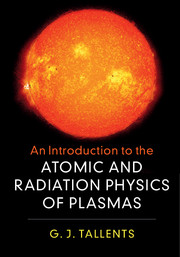Book contents
- Frontmatter
- Contents
- Preface
- 1 Plasma and Atomic Physics
- 2 The Propagation of Light
- 3 Scattering
- 4 Radiation Emission in Plasmas
- 5 Radiation Emission Involving Free Electrons
- 6 Opacity
- 7 Discrete Bound Quantum States: Hydrogen and Hydrogen-Like Ions
- 8 Discrete Bound States: Many-Electron Atoms and Ions
- 9 Discrete Bound States: Molecules
- 10 Radiative Transitions between Discrete Quantum States
- 11 Collisions
- 12 Collisional-Radiative Models
- 13 High-Density Plasmas
- Appendix Vectors, Maxwell's Equations, the Harmonic Oscillator and a Sum Rule
- References
- Index
9 - Discrete Bound States: Molecules
Published online by Cambridge University Press: 21 February 2018
- Frontmatter
- Contents
- Preface
- 1 Plasma and Atomic Physics
- 2 The Propagation of Light
- 3 Scattering
- 4 Radiation Emission in Plasmas
- 5 Radiation Emission Involving Free Electrons
- 6 Opacity
- 7 Discrete Bound Quantum States: Hydrogen and Hydrogen-Like Ions
- 8 Discrete Bound States: Many-Electron Atoms and Ions
- 9 Discrete Bound States: Molecules
- 10 Radiative Transitions between Discrete Quantum States
- 11 Collisions
- 12 Collisional-Radiative Models
- 13 High-Density Plasmas
- Appendix Vectors, Maxwell's Equations, the Harmonic Oscillator and a Sum Rule
- References
- Index
Summary
A molecule can be defined as a group of two or more atoms held together by sharing one or more electrons. Approximately equal electron sharing between atoms is said to produce a covalent bond between the atoms. The shared electron(s) in a covalent bond attract the positively charged atomic nuclei sufficiently to overcome the mutual electrostatic repulsion between the nuclei. When the atoms in a molecule are not the same element, the electron(s) may not be shared equally around the nuclei. Depending on the level of electron sharing, the bond or attraction between atoms can have a contribution due to a net negative charge near one atom (associated with that atom attracting more of the electron wavefunction) and a net positive charge near another, leading to an ionic bond.
We discussed the energy levels of atoms and ions comprising a single element in Chapters 7 and 8. In discussing the periodic table of the pure elements, we saw that, after placing electrons into sub-shells of increasing energy, the last un-filled subshell largely controls the chemical behaviour of the element as the wavefunction(s) of the electrons(s) in this sub-shell usually extend farther away from the nucleus so that these electrons are more likely to interact with neighbouring atoms.
Neutral and ionised molecules occur in plasmas if the particle temperatures are sufficiently low that vibrations and collisions do not have sufficient energy to cause the molecules to dissociate. In ‘plasma chemistry’, plasma ions react with surfaces or other plasma constituents to form molecules [36]. Temporary molecules are sometimes formed in plasmas. Charge exchange occurs when a neutral atom such as hydrogen interacts with a highly stripped ion (with no or few electrons) to form a temporary molecule. It has been shown that to achieve good accuracy the Rosseland mean opacity (discussed in Chapter 6) should include molecular transitions at temperatures below 5,000K [2].
We consider a simple molecular ion comprising two protons and an electron: the hydrogen ion molecule. The physics associated with this simple H2+ molecule illustrates the behaviour of more complex molecules and is relevant to plasma physics. Ionisation of neutral molecular hydrogen gas creates the hydrogen ion molecule.
- Type
- Chapter
- Information
- An Introduction to the Atomic and Radiation Physics of Plasmas , pp. 166 - 176Publisher: Cambridge University PressPrint publication year: 2018



